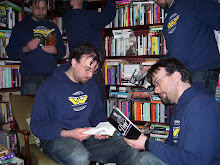The inestimable Will of
A Journey Round My Skull kindly pointed me in the direction of a new publishing venture co-headed by
David Pearson, often discussed on this blog. It's called White's Books, and the idea behind it is to produce beautiful hardback editions of established classics. Pearson does the typesetting himself, and invites some of his favourite designers to do the covers and endpapers. An
interview at the 'Creative Review' blog discusses the ideas behind the range and the designs in more depth, so here we'll just gawk at the books.
First, here's Pearson's own cover for Shakespeare's collected poetry.

Here is Petra Börner's
Jane Eyre. Börner was discussed on this blog earlier on
here.

This is Stanley Donwood's
Treasure Island, a lithographic print similar to his huge '
London Views' work detailing the destruction of England's capital by flood and fire. Some of you may also know Donwood through his design work for
Radiohead.

The last of the initial White's offerings is
Joe McLaren on Dickens.









4 comments:
I'm not sure about these. They have the Bronte and Stevenson in my local Waterstone's, but they're sealed so I couldn't check out the paper quality, typeface etc, which is presumably important to the design if Pearson himself is involved in the typesetting.
One thing I know I don't like about them is the fact that the top edges of the pages are blackened, rather like the hardback of Jonathan Strange and Mr Norrell. Always looks like a cheap and crude effect to me.
The typeface and page design is nice, but the blackened page top doesn't work for me either. When I was a poor teenager I used to buy remaindered books as Christmas presents, and hide the remainder marks by diligently blackening all of the page edges with a texta. I have no idea if anyone was fooled at the time, but now when I see blackened page edges it has the unfortunate connotation of incompetently hidden cheapness.
I bought the Dickens collection, and one thing I noticed is that on the right hand pages the first word of the next page is printed in the bottom right corner of the current page.
I'd not seen this before. Does anyone have any clues as to the origin of this practice? Presumably it is to improve reading speed as you turn the pages.
Paul: I'm not sure of the origins of that practice, but Pearson himself says: '[It's] an unusual text setting method rarely seen in the last hundred years. Each right-hand page sports what is known as a ‘catchword’: a hanging word that provides the opening of the following page. This aids the flow of reading, especially when using a larger, heavy page with a slow turning rate.'
Post a Comment